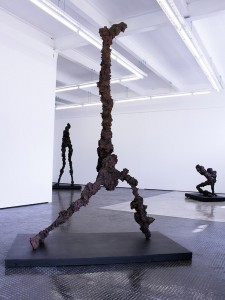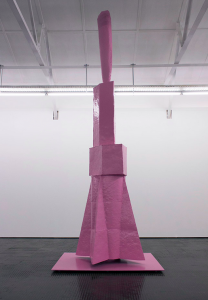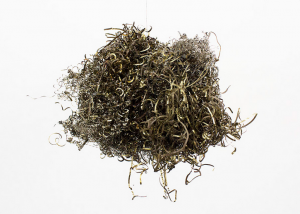SMAC Gallery, Cape Town
21.03.2015-02.05.2015
Forged, the past participle of the verb ‘to forge’, defines the process whereby metals are heated and hammered into shape by the blaze of the furnace. The very word is enveloped in a heroic Promethean mystique. It invokes the enigma of making, the magic whereby abstract mental constructs become tangible material realities. However forged also conveys fraudulence, fakery, the presentation of the facsimile as the genuine article.
Gail Catlin, in her method, is the most traditional of the artists on the exhibition ‘Forged’ at the SMAC Gallery in Woodstock. She moulds her clay with her hands, and it is during this process of modelling that her practiced fingers lovingly consummate what they are in the act of making. Modelling evokes all that intimate tactile foreplay, the pinching, prodding, squeezing, stroking, fondling that express the artist’s love of her materials and her longing to impose shape and form upon them. Then, theoretically, the blazing coals of the forge transmute the impermanent into the eternal.
The mainspring of Catlin’s sculpture has always been to refract her own personal experience through her immersion in the tribal art of five continents and many millennia. Her oeuvre is so promiscuously eclectic that it is impossible to trace Clarissa, Lucy, Priscilla and Peter’s art historical genealogy. Despite the genteel Home Counties names, Catlin’s sculptures are completely timeless works of pure primitivist inspiration, but whether African, Khoisan, Oceanic, Pre-Columbian, Inuit, Amerindian, or a mélange of all six, is a moot question.
Lucy is both ancient and modern. Although she looks like a force-fed, Strasbourg goose there are formal affinities to Giacometti’s anorexic Auschwitzian women. Catlin’s Expressionist allegiance emerges in the sheer gestural energy she lavishes upon her bronzes which achieve a raunchy immediacy unique in the national canon. Catlin maintains that all her work is self-portraiture inspired by her traumatic childhood, years of artistic experiment, marital disappointments, betrayal, and abandonment and, last, but not least, child-bearing, child-rearing and the tragic loss of one of her eight offspring.
Lucy is the first sculpture to confront us as she rises up alone in the splendid isolation of the first gallery, effortlessly transforming the space into her via dolorosa, her site of martyrdom. Catlin consistently explores the dolorous extremities of the feminine condition, and Lucy whose disfigured body is scarred by time, pain and exhaustion, also dwells on the onset of age, loss of looks and deepening solitude. However her effigy not only records her insecurity, doubt and dread, it also commemorates her indomitable will to survive.
Lucy is rudely naked, rather than decorously nude – a primal force of nature utterly unabashed by her kalgatheid. An elemental earth goddess, she personifies rampant libido and a broad-hipped, mare-like fertility. She stands with her legs widely parted. Her breasts are prominent, her nipples stiff with arousal, and if she dropped to her knees to fellate the viewer, he would be gratified, but hardly surprised.
Even as a student, Barend de Wett embodied everything that was hip, sharp and kickass. He was the dada prankster who believed art should be fun, and at Forged he continues breaking the rules, spurning convention, and producing work more reminiscent of Coney Island than the Royal Academy.
The keynote of de Wett’s buoyant, popsicle-coloured bronzes are a glowing, child-like faith in dreams, legends, fairy tales and that miraculous site somewhere over the rainbow. In his Baby Blue, Baby Pink and Snake, the familiar nursery hues and muted pewter glow replace the Verdigris of weathered bronze, the immemorial hue of sculptural hagiography commemorating the often equivocal ‘great men’ of yore like Cecil John Rhodes. The purity of the baby blue and pinks, and their associations with infantile innocence permeate the imposing white cube with the domestic intimacy of a playpen, infantilizing the figures and endowing them with an endearing toy-like charm. They lose their usual heroic and epic associations with men of action, and instead embody a perky childish optimism.
The trio are proclamations of faith in a better tomorrow, drawing on propitious symbols such as stars and rockets. To defeat gravity and reach for the sky is a fundamental human urge, and de Wet’s Pinky and Bluey stand so ready for take-off that their presence seems as provisional as it would be at Cape Canaveral. The pair are gendered, an ideal couple of the future as they proudly stand their ground, and rise up in clearly defined sections of different facetted geometric designs.
There is also a plump and lazy serpent far too guileless to have ever colluded with Eve. It has a faucet at one end, and sprawling on the original black factory floors of the SMAC Gallery, it reminds me of some bloated, creepy-crawly basking in the eternal sunshine of a Sandton swimming pool. Snake represents the umbilical cord rooting humanity to the earth. Snakes are both the embodyment of Freudian sexual drive as well as skin shredding symbols of renewal, de Wet’s Snake conjoins Pinky and Bluey inspiring them to attain something neither of them could achieve on their own.
Ruann Coleman, born in 1993, belongs to the ‘voel-vry’ generation who longed to rid their work of their predecessor’s glums fixation on intractable political and socio-political questions. Instead of practising an earnest, issue-driven art, Coleman expresses himself in a purely formal language inflected with an irony and wit that indicate that nothing he does can be taken at face value.
While Catlin and de Wet’s statuary rises stoutly from the floors, Coleman’s far frailer creations rely on the ceiling or wall for support. His sculpture is based on play, impromptu juxtapositions, chance and the serendipity of random accident, and, in general, it renounces grandiosity and appears plain, modest, and unassuming. His inspiration springs from the canonical modernists like Brâncuși and the minimalist aesthetic of the crisp, the lean, the clean and the pared down. His other allegiance is to Duchamp, the ready-made and the objet-trouve. Most of Ruann’s works consists of the most ordinary of materials found in scrap heaps and metal yards, and usually he subjects them to the minimum of artistic interference.
Draadtrek is a dense entanglement of razor-sharp steel shavings in subtle shades of brown and bronze that becomes increasingly dense as its lines move toward their center of gravity. The piece looks like an unravelling bird’s nest, and is suggestive of the ideas of the pain and pleasure – draadtrek after all implies masturbation in Afrikaans.
In Study 11 the delightfully antiquated, intricate miniature compass supports thin curved rods of bronze and brass in a tender embrace allowing it, like Draadtrek, the freedom to move and respond to the breeze. Coleman uses his own body to shape his work, bending it around his frame so that his physique actually dictates its form, and assumes his identity. Like the wayward trajectories seen in Draadtrek, it revolts against the fixity of Catlin and de Wet’s work, and instead relies on the grace of circular movement, minimal as it may be.










